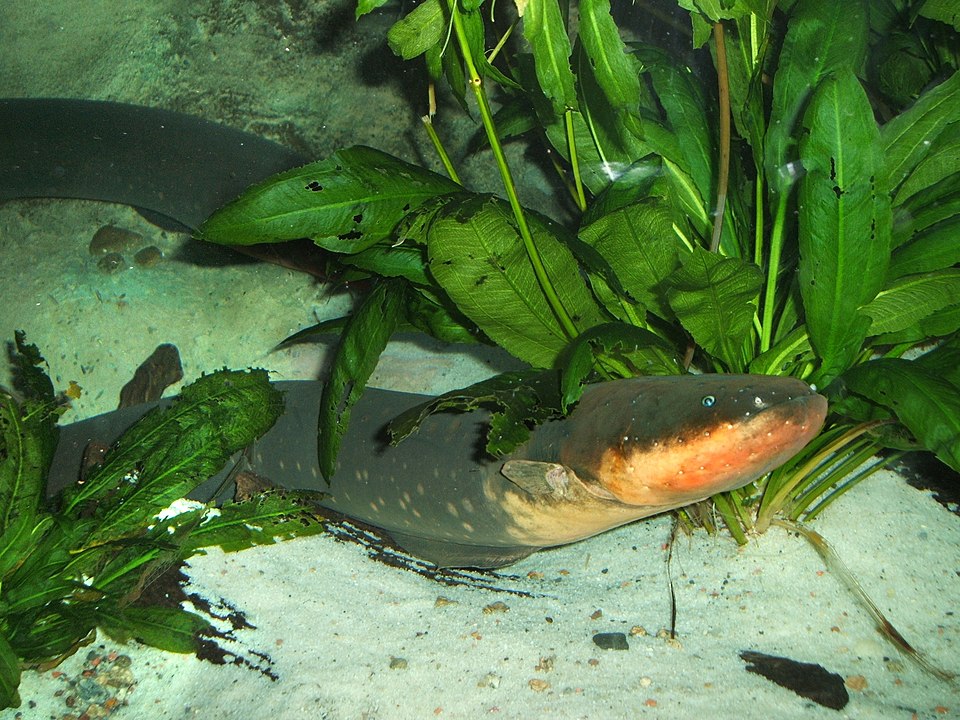
I learned this today. An electric eel produces electricity in the same way that a battery does.
Electric eels usually grow to be about 2m long and they have three organs that they use to make electricity. These are called the main organ, Hunter’s organ, and Sach’s organ. These three organs take up most of the electric eel’s body. The eel uses the main organ and the Hunter’s organ to make high voltage electricity and the Sach’s organ to make lower voltage electricity.
Inside these organs, eels have cells called electrocytes. These are a type of muscle cell that have become modified for their job. The look like tiny, flattened sausages. Inside the organ, there are columns of 5,000 to 10,000 of these electrocytes and there are about 70 columns on each side of the organ.
When the eel wants to make electricity, an electrical signal is sent from its brain to a command nucleus. This command nucleus then sends a signal to all of the electrocytes at the same time. It does this in a way that the signal reaches all of the electrocytes at exactly the same time.
The electrocytes are joined to the nerve at one side but not on the other. This makes an electrical difference between the outside of the electrocyte and the inside because the outside of the electrocyte has a negative charge of about 100 millivolts. When the signal to fire arrives, the electrocyte releases a tiny amount of acetylcholine, which is a neurotransmitter. This neurotransmitter creates a path of low resistance that connects the outside and the inside of the cell. This makes the electrocyte cells work in the same way that a battery works. There is a negative charge on one side of the cell and a positive charge on the other. This electric potential difference creates an electric charge of about 150 millivolts. That is not much, but it quickly builds up because there are tens of thousands of cells in the eel.
Eels can produce about 500 volts along their body and their head and tail become positive and negative poles. That is strong enough to knock down a horse and cause heart failure in people.
The electric eel uses the Hunter’s and main organs for strong charges. It needs these to defend against predators and to stun prey. The electric eel can also use this electricity to control the nervous system of its prey. They can use it to stop prey from swimming away, or to make hidden prey twitch and reveal itself.
The Sach’s organ is used to produce a weaker electric charge. This gives the electric eel the ability of electrolocation. Electric eels have receptor cells on their skin called ampullary receptors. These detect the electrical fields of the eel and of other animals. The eel can monitor changes in its electromagnetic field and can “see” its environment. This can help the eel to detect prey. They also use this low electric charge as a way to communicate with other eels. They can make pulses, which other eels can detect.
Some people have proposed using electric eels as a power source, but they are not as efficient as they sound. They have to eat a lot of food to be able to produce the current that they do. A battery is far more efficient. However, scientists have created a new type of battery that they modeled on the electric eel. This battery is flexible, uses water, and can produce power in places a battery wouldn’t work. It could be used on underwater robots, or it could run inside the body, powering a pacemaker.
Lastly, electric eels are not actually eels at all. They are knifefish, a type of fish that is related to the catfish.
So, electric eels produce an electric charge by creating a potential electric difference across electrocyte cells in their bodies. This small charge adds up over the tens of thousands of electrocyte cells. They have three organs (main, Hunter’s and Sach’s) that they use to produce electricity. They can produce large charges to stun prey or defend themselves and they can produce small charges to communicate and “see” their environment. And this is what I learned today.
Sources
https://www.businessinsider.com/why-electric-eels-dont-electrocute-themselves-2015-3
https://www.uwa.edu.au/science/-/media/Faculties/Science/Docs/Electric-eels.pdf
https://www.scientificamerican.com/article/how-do-electric-eels-gene/
https://en.wikipedia.org/wiki/Electric_eel
